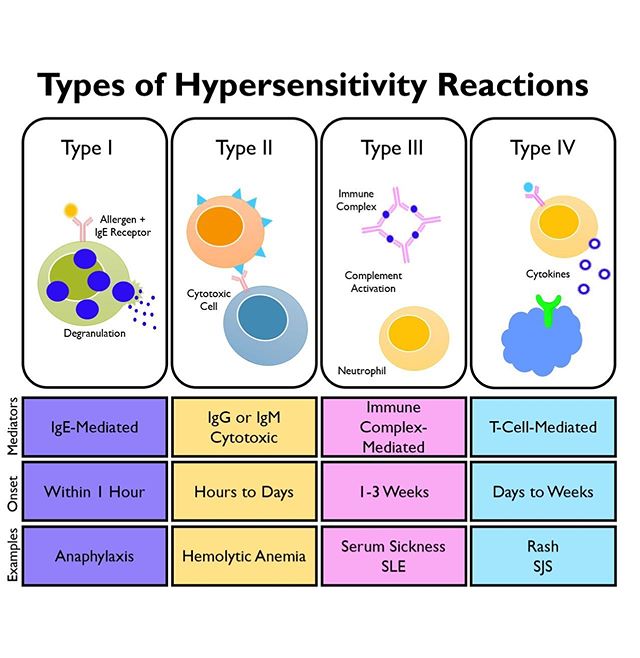Definition:
- Hypersensitive reactions are inflammatory reactions within the humoral or cell mediated branches of the immune system that lead to extensive tissue damage or even death.
- The four types of hypersensitive reactions (Gell and Coombs classification) generate characteristic effector molecules and clinical manifestations
Type I Hypersensitive Reaction
- It is mediated by IgE antibodies whose Fc portion binds to receptors on mast cells or basophils.
- Crosslinkage of the fixed IgE by allergen leads to mast cell or basophil degranulation with release of pharmacolgically active mediators.
- The principle effects of these mediators are:
* Smooth muscle contraction
* Vasodilation
* Systemic anaphylaxis
*Localized responses:Hay fever & asthma

Components of Type I Reactions
- Allergens
- Reaginic antibody(IgE)
- Mast cells and Basophils
- IgE binding Fc receptors
*High Affinity Receptors
* Low Affinity Receptors



P-K test (Skin test)

Reactivity of Atopic serum in P-K test

High and Low affinity IgE Receptors

Principal Mediators of Type I Hypersensitivity


Type II Hypersensitive Reaction
- A type II hypersensitive reaction occurs when antibody reacts with antigenic determinants present on the surface of cells leading to cell damage or death through complement mediated lysis or antibody –dependent cell mediated cytotoxicity (ADCC).
- Trasfusion reactions and hemolytic disease of the new born are type II reactions.


Structure of ABO blood group antigens

Development of Erythroblastosis Fetalis (Hemolytic Disease of new born)

Type III Hypersensitive Reaction
- A type III hypersensitive reaction is mediated by the formation of immune complexes and the ensuing activity of complement system.
- Complement split products serve as immune effector molecules that elicit localized vasodilation and chemotactically attract neutrophils.
- Deposition of of immune complexes near the site of antigen entry can induce Arthus reaction. In this lytic enzymes released by accumulated neutrophils and the complement membrane attack complex cause localized tissue damage.


Type III hypersensitive Reaction (Arthus Reaction)
Type IV Hypersensitive Reaction
- It involves the cell mediated branch of the immune system.
- Antigen activation of sensitized TH 1 cells induce release of various cytokines that cause macrophages to accumulate and become activated.
- The net effect of the activation of macrophages is to release lytic enzymes that cause localized tissue damage.



Overview of DTH response



















